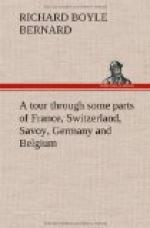Brussels is a city of great extent, built partly on the river Senne (naturally a very inconsiderable stream, but which, being formed here into a canal, becomes of much advantage), and partly on a hill, commanding an extensive view of the rich and fertile plain by which it is surrounded; much of which resembles a vast kitchen garden. It is, like Louvain, surrounded by a ruined wall of brick, as formerly all the towns of Flanders were fortified. This was the capital of the Austrian Netherlands, and lately the chief place of the French department of the Dyle: it will, probably, now become, for a part of the year, the residence of its new sovereign, whose sons are at present amongst its inhabitants. The inhabitants of Brussels are calculated at 70,000, and its environs give the traveller an idea of its importance, as they have an appearance of much traffic and are decorated with many villas which announce the opulence, but not always the good taste of their owners. The city is, in general, irregularly built, and the lower part does not deserve commendation; but the place royale is fine: the park is surrounded by many handsome public buildings, and by a number of private houses, which would ornament any capital in Europe. The park is of considerable extent, and forms an agreeable promenade. Its avenues are kept in excellent order; they abound with statues and other formal decorations, which are, however, more admissible in a city promenade than in the retirement of the country. A fountain here was celebrated by Peter the Great’s having fallen into it, as that monarch, like Cato, was said,
“Saepe mero caluisse virtus.”
“His virtue oft with wine to warm.”
The circumstance was recorded by the following inscription:
“Petrus Alexowitz,
Czar Moscoviae, magnus dux, margini hujus fontis
insidiens, illius aquam
nobilitavit libato vino hora post meridiam
tertia, die 16 Aprilis,
1717.”
“That renowned General P.A., Czar of Moscovy, having poured forth ample libations of wine, whilst sitting on the brink of this fountain fell into, and ennobled its waters about three o’clock in the afternoon of the 16th of April, 1717.”
The town-house is one of the most conspicuous of the public buildings at Brussels, although it is situated in the lowest part of the town, its steeple rising to the height of 364 feet; it is a very fine piece of Gothic architecture. The equestrian statue, noticed by M. Dutens, as being placed on the top of a house in the square before the town-house, has disappeared; the horse and his rider having been removed to a more suitable situation. The church of St. Gudule presents a venerable and interesting appearance; it contains several fine paintings, and windows of stained glass. There are many ancient tombs of the old Dukes of Brabant. The church of St. James is also worthy of notice, and its facade of the Corinthian order, is an elegant and uniform piece of architecture, which does honour to the taste of the builder.




